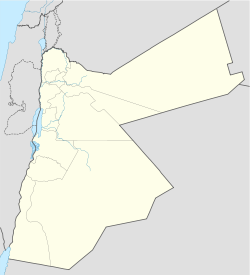- Deir Alla
-
Coordinates: 32°11′20″N 35°36′11″E / 32.18889°N 35.60306°E
Deir Alla
مدينة دير علا— City — Shrine of Abu Ubaidah ibn al Jarrah in Deir Alla
Flag
SealLocation in Jordan Coordinates: 32°11′20″N 35°36′11″E / 32.18889°N 35.60306°E Country Jordan Province Balqa Governorate Municipality established 1967 Government – Mayor Khalifa Solomen Diyat Elevation -1,030 ft (-314 m) Population (2004) – City 6,899 (2,004) – Metro 46,481 (2,004) – Ref 2,004 Census Time zone GMT (UTC+2) – Summer (DST) +3 (UTC) Postal code Area code(s) +(962)5 Website http://deirallacity.gov.jo/ Deir Alla (Arabic: دير علا), (in modern Balqa Governorate, Jordan) is the site of an ancient Near Eastern town thought to be Pitru/Pethor.
Contents
History
The town was a sanctuary and metal-working centre, ringed by smelting furnaces built against the exterior of the city walls,[1] whose successive rebuildings, dated by ceramics from the Late Bronze Age, sixteenth century BCE, to the fifth century BCE, accumulated as a tell based on a low natural hill. The hopeful identification of the site as the Biblical Sukkot is not confirmed by any inscription at the site.
Deir Alla was the first Bronze Age city excavated in Jordan. The initial expectations were of establishing a relative chronology of Palestine pottery in the transition between the Bronze Age to the Iron Age, established through meticulous stratigraphy. It was intended to span a gap between established chronologies at Jericho and Samaria.[2]
The oldest sanctuary at Deir Alla dates to the Late Bronze Age;[3] it was peacefully rebuilt at intervals, the floor being raised as the tell accumulated height, and the squared altar stone renewed, each new one placed atop the previous one. The final sanctuary was obliterated in a fierce fire; the blackened remains of an Egyptian jar bearing the cartouche of Queen Twosret gives a terminus post quem of ca 1200 BCE, a date consonant with other twelfth-century urban destruction in the Ancient Near East.[4] Unlike some other destroyed sites, Deir Alla's habitation continued after the disaster, without a break, into the Iron Age; the discontinuity was a cultural one, with highly developed pottery of a separate ceramic tradition post-dating the destruction. On 20 August 2010 it recorded a scorching temperature of 51.1C, the new official highest temperature in the history of Jordan. [5]
Archaeology
A series of Dutch excavations sponsored by the Netherlands Organisation for the Advancement of Pure Research began in 1960, under the auspices of the department of theology, University of Leiden. These excavations continued for five seasons until 1967. The excavation made its most dramatic discovery in 1967, an ink wall inscription relating a hitherto-unknown prophecy of Balaam, who thereby becomes the first Old Testament prophet to be identified in an inscription.[6]
At the end of the 1964 campaign, 11 clay tablets, 3 inscribed in a hitherto unknown possibly alphabetic script, 7 bearing only dots, and one uninscribed, were discovered. [7]
The Balaam inscription
The 1967 excavation revealed a many-chambered structure that had also been destroyed by earthquake, during the Persian period at the site, in which was found a previously unknown prophecy by the seer and prophet Balaam, written in an unattested peripheral local dialect, with Aramaic and South Canaanite characteristics, which employed an idiosyncratic script.[8] The Deir Alla Inscription is datable to ca. 840-760 BCE; it was painted in inks[9] on fragments of a plastered wall: 119 pieces of inked plaster were recovered. The wall, near the summit of the tell, was felled by yet another tremor.[10]
Touristic attractions
As well as being the site of the Deir Alla Inscription, Deir Alla is also the site of Battle of Fahl between the Muslim Caliphate and the Byzantine Empire. There are several tombs of Sahaba (followers of Muhammad) in Deir Alla:
- Abu Ubaidah ibn al Jarrah (أبو عبيدة عامر بن الجراح )
- Dhirar ibn al Azwar
- Shurahbeel ibn Hassana
Notes
- ^ Metal slag was found at every level, and often-rebuilt furnaces. (H.J. Franken, "The Excavations at Deir ʿAllā in Jordan" Vetus Testamentum 10.4 [October 1960, pp. 386-393], p 389).
- ^ Franken 1960:386-393.
- ^ There had been earlier, but unrelated Chalcolithic inhabitants of the tell. (1961:371)Franken
- ^ H.J. Franken, "The Excavations at Deir ֝Allā in Jordan: 2nd Season" Vetus Testamentum 11.4 (October 1961), pp. 361-372.
- ^ http://www.jordanweather.jo/article_55
- ^ H. J. Franken and Ah J. Franken, Excavations at Tell Deir Alla: the Late Bronze Age Sanctuary, David Brown, 1992, ISBN 9068314084
- ^ W.H. Shea, "The Inscribed Tablets From Tell Deir `Alla" Andrews University Seminary Studies, vol. 27, pp. 21-37, 97-119, 1989.
- ^ Jo Ann Hackett, The Balaam Text from Deir ʿAllā. (Harvard Semitic Monographs 31) 1980, released 1984.
- ^ Red and black inks were used, apparently to emphasize the text.
- ^ J. Hoftijzer and G. van der Kooij, "Aramaic Texts from Deir 'Alla" Documenta et Monumenta Orientis Antiqui 19 (Leiden) 1976.
See also
Categories:- Populated places in the Balqa Governorate
- Archaeological sites in Jordan
- Former populated places in Southwest Asia
Wikimedia Foundation. 2010.





